 Yokokawa depot dedicated to banking work
on the Yokokaru section.
Yokokawa depot dedicated to banking work
on the Yokokaru section.
On the Shinetsu main line connecting Tokyo to Naoetsu on the Sea of
Japan coast, there is a steeply grading section, so called Yokokaru
(between Yokokawa and Karuizawa). This 11.2km section climbs over the
Usui pass, which used to be one of the greatest natural barrier with
high hills, rising above one another, and prevented railway
construction for years at dawn of railway days. The barrier was finally
overcome with an Abt rack rail system when the section was opened in
1893. Some Abt system locomotives were allocated at Yokokawa depot to
assist trains going through this section with additional motive or
braking power. The banking locomotives were first steam and then
converted to electric units when the section was electrified on 600V DC
in 1912.
The section was
rebuilt in 1968 on a longer double track route with alleviated 6.7%
grading, getting rid of the troublesome rack rail system. At that time,
newly designed EF63s came to Yokokawa depot, and since then, they have
been working on banking duties on this section.
This historic
Yokokaru section is going to be discontinued soon upon the opening of
the paralleling Nagano Shinkansen which links between Tokyo and Nagano,
where 1998 Winter Olympics are going to be held. The photos below were
taken at Yokokawa by Hiroshi Naito on July 5th 1997.
 Yokokawa depot dedicated to banking work
on the Yokokaru section.
Yokokawa depot dedicated to banking work
on the Yokokaru section.
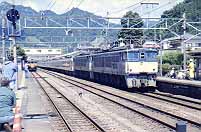 A
limited express Asama assisted by banking EF63s are pulling into
Yokokawa station.
A
limited express Asama assisted by banking EF63s are pulling into
Yokokawa station.
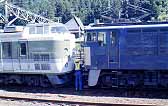 Banking EF63
being removed from Asama.
Banking EF63
being removed from Asama.
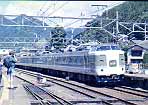 189 series Asama pulling out of Yokokawa station heading
for Tokyo.
189 series Asama pulling out of Yokokawa station heading
for Tokyo.
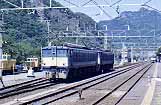 EF63s are
in their blue livery.
EF63s are
in their blue livery.
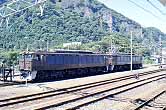 EF63s
are in their original brown livery
EF63s
are in their original brown livery
At Nagano Station
 DMU Kiha 58 (left) and Kiha 20 (right) in
local work for the Iiyama line.
DMU Kiha 58 (left) and Kiha 20 (right) in
local work for the Iiyama line.
 New 383 series in Shinano service between Nagoya and
Nagano via Chuo-west and Shinonoi lines.
New 383 series in Shinano service between Nagoya and
Nagano via Chuo-west and Shinonoi lines.